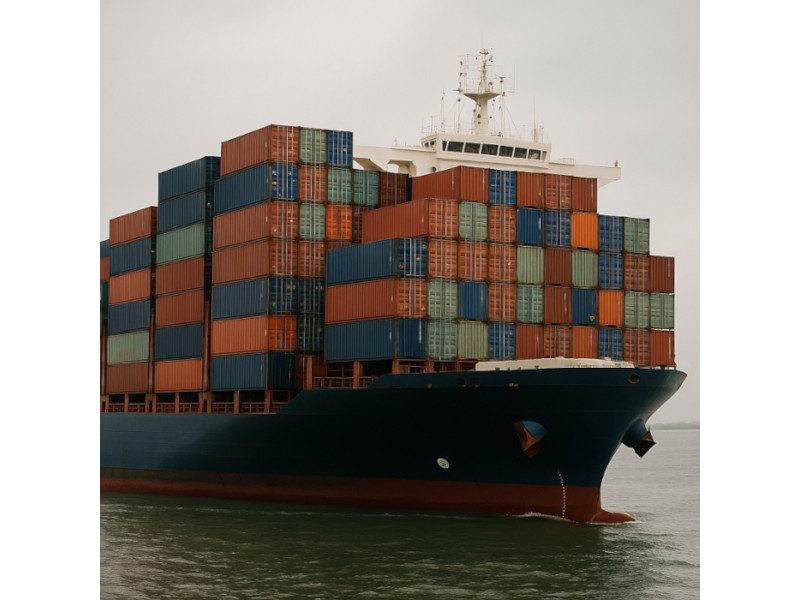ITM Editor Joseph Clarke navigates the digital technologies and solutions that have the potential to revolutionise the shipping industry
Maritime transportation has long been the foundation of our global economy, with more than 90% of the world’s trade in goods being possible thanks to shipping. Since the Covid-19 pandemic, there has been an even greater recognition of the significance of the maritime sector and its need to be resilient.
With the vital role that the shipping industry and its associated logistical networks played during the global crisis, delivering essential resources and supplying food to different communities, while sustaining economies, the importance of shipping became ever more apparent. Yet so too did the multiple vulnerabilities within the sector and therefore the need to make resilience a top priority. This is why the digitalisation of shipping has become more crucial than ever.
Maersk’s Beyond the Box Episode 2: Digitising global trade., explains that “digitalisation in shipping and Logistics represents a fundamental redraw of Global Supply chains that will profoundly change global trade for both businesses and consumers technology will increase the scale scope and speed of trade it can provide access to markets for everyone regardless of geography or Business and right now we’re looking into the biggest evolution of global trade since the containerisation in the late 60s.”
Reasons for digitalisation
Leveraging the capabilities of digital technology holds the potential to enhance the performance of the maritime industry and effectively address numerous pressing challenges that it presently faces, as evidenced by findings from the recent World Bank-IAPH report on a global scale, the more extensive and well-coordinated utilisation of digital technology could lead to substantial improvements in efficiency, bolstered safety and resilience in supply chains, and reduced emissions.
More specifically, the establishment of a streamlined digital ecosystem can greatly simplify operations and facilitate the seamless exchange of data among shipping companies, port services, cargo handling operations, clearance agencies and other transportation networks. Amid the backdrop of the Covid-19 pandemic, digital technology also offers the advantage of minimising the necessity for human interaction, thus serving as a protective measure for the sector against possible future disruptions.
At a conference organised by the International Maritime Organization (IMO) and the Maritime and Port Authority of Singapore (MPA), named ‘Future of Shipping: Digitalization. Maritime Perspectives Series’, IMO Secretary General Kitack Lim recognised the potential of a digital shipping industry, commenting:
“Driving the digitalisation of shipping is more important than ever. Increased data collection, processing and interconnectivity capabilities, enable automated systems to be controlled remotely or through artificial intelligence. Increased automation in shipping has the potential to enhance safety, to improve environmental performance, and to ensure more efficient and sustainable shipping.”
Nevertheless, despite the numerous benefits of digitalisation in shipping having been recognised, and even more so over the last few years, progress in this regard has been slow and somewhat uneven. In fact, as the World Bank-IPAH report highlights, even after the IMO mandated electronic data exchange for all its member nations, a recent survey conducted by the IAPH revealed that just one-third of the over 100 surveyed ports are in compliance with this requirement.
The report goes on to note that, in the short term, countries that fall behind in this digital transformation may encounter shortages of vital commodities and increased prices, as was evident at the onset of the pandemic. In the medium to long term, postponing the digitalisation of the maritime supply chain could result in elevated trade expenses, reduced competitiveness, decreased economic growth and a decline in employment. On a broader scale, this situation could exacerbate the economic disparity between developed and developing nations, further isolating the poorest countries. Crafting effective solutions for smaller countries and small island developing states will be a crucial aspect of addressing this issue.
In a nutshell, the reasons to digitalise are evident, but progress is not where it needs to be. Moving forwards, the maritime industry needs to be aware of the opportunities, the risks and the measures to cope on this digital voyage. But while digital development may not have been as fast as it has been in other sectors, many experts are optimistic. DNV, an independent expert in risk management and assurance, believes that digitalisation is gaining fast ground, stating that “the transition towards digitalisation and automation is speeding up in the maritime industry.”
Their article titled ‘Digitalisation in the maritime industry’ explains that “digital technologies and solutions are being used to increase competitiveness and enhance operational efficiency. They are also being implemented to spur the industry along the decarbonisation path to realise zero emissions from international shipping by mid-century,” and concludes that in order “to secure efficient, sustainable operations and strengthen short- and long-term competitiveness, maritime stakeholders need to re-think their current strategies and adapt.”
Digital measures
The most common methods of digitalisation in shipping encompass a wide range of technologies and processes aimed at improving various aspects of the industry. According to research carried out by Lambrou, Watanabe and Lida, published in the Journal of Shipping and Trade, “digital innovation in shipping is articulated along three basic pillars”. These three key areas are innovative digital technologies, like IoT and blockchain; innovative digital solutions, like smart shipping systems and services; and digital business concepts, models and management practices.
With regards to digital technologies and solutions, IoT is a fast-growing trend in the maritime industry. With the help of the Internet of Things, physical devices are equipped with sensors and have the ability to capture data, which is then shared with websites. This information can then be analysed in real time to become aware of discrepancies or inefficiencies and provide immediate solutions to enhance performance. While IoT solutions can gather information from multiple data points at any given time, to provide a global analysis of overall performance levels, they can also hone in on individual items for more localised tracking and monitoring purposes.
Through the implementation of Internet of Things (IoT) technology, shipping companies and maritime organisations can effortlessly monitor the whereabouts of cargo. This is made possible by employing IoT sensors either on the intelligent container itself or within the cargo items. Such a system offers significant time-saving benefits for all parties involved, allowing shippers and freight forwarders to closely track cargo as it crosses the seas and reaches its destination port.
Don Miller, Co-Founder of Greensee, recogonises that at the heart of the digital transformation of shipping lies the convergence of both the Internet of Things and sustainability. He states:
“In today’s fast-paced global marketplace, supply chain digitalisation has emerged as a game-changer for businesses seeking efficiency, transparency, and resilience. At the heart of this transformation lies the convergence of two critical elements: the Internet of Things (IoT) and sustainability.
“IoT, with its web of interconnected sensors, has revolutionised supply chains. These smart sensors provide real-time data on inventory levels, transportation conditions, and production processes, allowing companies to make informed decisions swiftly. This data-driven approach not only reduces operational costs but also enhances customer satisfaction through improved delivery accuracy and speed.”
However, as Don also points out, the impact of supply chain digitalization goes beyond mere efficiency:
“Sustainability has become an undeniable priority in today’s world, and digitalisation is a key enabler of sustainable practices. IoT technologies help companies calculate emissions accurately, monitor and optimise energy consumption, reduce emissions, and minimise food wast and loss. Moreover, digitalisation enables better traceability, ensuring the sourcing of sustainable materials and ethical labour practices.
“By integrating IoT and sustainability into supply chains, businesses can achieve a double benefit. They not only optimise operations and reduce costs but also demonstrate their commitment to environmental and social responsibility, thereby attracting eco-conscious consumers and partners. In an era defined by global challenges like climate change and resource scarcity, supply chain digitalisation powered by IoT and sustainability is not just a competitive advantage but a necessity for a sustainable future.”
Blockchain is also at the forefront of shipping’s digital voyage, offering all parties involved along the supply chain a seamless and secure transfer of data. In an article published by Hill Dickinson, titled ‘Can blockchain technology revolutionise the shipping industry?’, Mark Weston and Michael French explain that the shipping industry has a lot to benefit from the use of blockchain technology, given the complexities of global shipping and the number of individuals involved, as well as the current reliance on paper documents.
Weston and French identify that as “the cost of trade documentation is estimated to be one fifth of the cost of transportation, the saving that can be achieved appears to make the use of blockchain technology worthwhile in itself, although there is an upfront establishment and implementation cost, of course.” They go on to explain that blockchain technology will reduce risks and costs by automatically and securely issuing and tracking the necessary shipping, finance or insurance documentation in a safe way. Recognising the real opportunities for the shipping sector if it is able to successfully adopt blockchain technology on a greater scale, Weston and French conclude:
“There are real opportunities for the shipping sector if it is able to implement blockchain technology on a large enough scale and across enough of the many organisations involved in the industry. With the large-scale implementation comes reduced processes, barriers and costs. This could make shipping a more viable option for more consignments, which could increase demand within the industry by up to 15%.”
In summary, these methods of digitalisation are transforming the shipping industry by enhancing reliability and efficiency, reducing costs, improving transparency, and ensuring compliance with evolving regulatory standards. As technology continues to advance, we can expect further innovations in the digitalisation of shipping processes.
Risks
With the increasing use of digital technologies inevitably comes risk. While blockchain seems to be a favourable and successful method to overcome the risk of data security, cybersecurity remains a threat that needs to be given attention.
As the shipping industry continues to embrace digitalisation, integrating with cloud-based systems, there is a growing likelihood of cyberattacks or unauthorised interference. While digitalisation offers benefits in terms of enhanced efficiency and safety, it also exposes stakeholders to a novel set of security threats. Recognising these risks, in 2021 the IMO mandated that vessel operators incorporate measures to mitigate potential cyber risks into their management systems.
It is essential for the shipping industry to invest in robust cybersecurity measures, data protection practices and employee training. Additionally, a comprehensive risk management strategy should be in place to identify, assess and mitigate potential digitalisation-related risks. Regular audits and updates to digital systems and processes can help ensure their security and effectiveness.
Tanushree Garg, Technology Service Engineering, A.P. Moller – Maersk, explained:
“Cyber security and data protection measures will go a long way in building credibility in building trust and confidence in the digitisation outcomes. These practices need to be built in organisational DNA and be part of solutions from the get-go. This also includes a strong process around evolving regulations in shipping digitisation and ensuring compliance.”
Conclusion
There is no denying that while digitalising the shipping industry offers multiple benefits, so too does it come with its challenges, but resisting this digital change is only going to delay the inevitable.
Digitalisation enables the automation of various processes and functions, while the integration of data streams from diverse sources enhances the speed of decision-making, resulting in more efficient and adaptive organisations. However, for digitalisation to enhance safety reporting standards, shipowners must develop a well-defined and attainable roadmap. This entails evaluating their existing digital systems as many still retain unused software licenses and outdated legacy technologies.
As the World Bank rightly points out in an article titled ‘Accelerating Digitalization Across the Maritime Supply Chain”, in order to effectively deal with the multiple stages of digitalisation, agents from across the maritime supply chain must do a lot more than just invest in technology and digital infrastructure. In fact, what is needed is a successful digital transition which “requires sustained political commitment, adequate regulation, effective collaboration between the public and private sectors, along with a concerted effort on education and skills training.”
Despite being risky, the maritime industry needs to digitise and share necessary data. If all links to the supply chain were to do just that, shipping would become much more efficient, and the benefits would be reaped by both businesses and customers. It is by working and going digital together that the shipping industry will become fully fruitful for everyone onboard.
Read more news and exclusive features in our latest issue here.
Never miss a story… Follow us on:
International Trade Magazine
@itm_magazine
@intrademagazine
Media Contact
Joseph Clarke
Editor, International Trade Magazine
Tel: +44 (0) 1622 823 920
Email: editor@intrademagazine.com







